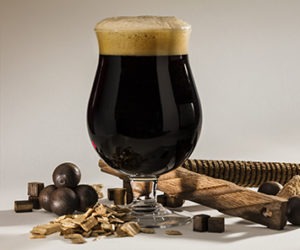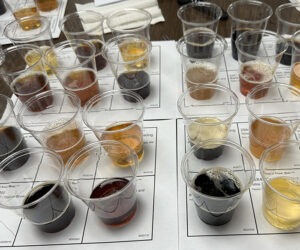Dealing with Diacetyl: Tips from the Pros
Brewer: Ashton Lewis, Springfield Brewing Company in Springfield, MO
With the exception of a very few notable lagers, diacetyl is considered completely unacceptable in the style. The interesting thing about the obsession with diacetyl in modern brewing, especially among lager brewers, has nothing to do with diacetyl’s association with bacterial contamination.
Beers containing diacetyl, whether the consumer knows it or not, are satiating and make beer drinkers feel full. This translates to decreased beer consumption during a beer drinking session and a corresponding drop in beer sales. My tips to minimize diacetyl are:
1. Use a 3-day diacetyl rest for ales and a 7-day diacetyl rest for lagers following primary fermentation.
2. Select a yeast strain not noted for diacetyl production.
3. Minimize air pick-up during racking, filtration and packaging because oxygen causes alpha-acetolactate in beer to convert to diacetyl.
4. Keep a clean brewery and use clean yeast since lactic acid bacteria and Pediococcus can both cause diacetyl problems in beer.
Brewer: John Nielsen, Prescott Brewing Company in Prescott, AZ
Diacetyl (also known as 2, 3 butanedione) is a naturally occurring part of the fermentation process. Its profile is a distinct buttery aroma and flavor; some say it’s like buttered popcorn or butterscotch. Some Belgian ales contain higher levels of diacetyl and it is considered part of the flavor profile — however in most ales it is found in small amounts. However, in lagers it is typically considered a defect.
Another source of diacetyl is bacterial contamination. There are two main types of bacteria that can cause diacetyl to form — Lactobacillus and Pediococcus. The first thing anyone should do is review all sanitation procedures and make sure everything is properly sanitized.
As mentioned earlier, diacetyl is a natural occurring process of fermentation. The yeast will produce diacetyl no matter what. However, just as the yeast produces diacetyl, it will also get rid of it. You must let the fermented beer sit on the yeast for two or three days after the termination of fermentation. This is called the diacetyl rest. The yeast will scrub the diacetyl out of the beer that it produced. After the rest, rack your beer into your mini kegs or bottles.
For homebrewers, if you don’t have temperature controls on your equipment, allow the yeast to ferment the beer to about half of the terminal gravity, then allow it to warm up to about 65 ºF (18 ºC). It should reach this temperature on its own, if not, a water bath a little warmer than the beer will help it along. The beer will be far enough along in the fermentation process so the yeast shouldn’t produce these flavors. Leave the beer at this temperature until there is no more diacetyl in your beer, then rack your beer for cold lagering.
How will you know when the diacetyl is gone? Easy, test for it. Take two samples of beer (about 3 ounces each) and put them each in a sealed jar. Mark one sample A and one sample B. Place sample A in the fridge, take sample B and heat the sample up to 140–150 ºF (60–66 ºC) and hold that temperature for no less than 20 minutes. Then place sample B in the fridge and chill. When sample B has reached temperature equal to sample A, take both samples out of the fridge and open A first. Swirl it and taste it, then open B and do the same. If you smell or taste any buttery notes, let the beer sit on the yeast longer. If they both smell and taste the same then you are ready to move on to the next step — bottling or cold lagering.
Brewer: Bill Kiester, Backcountry Brewery in Frisco, CO
Diacetyl, while present in many ales, is deemed more of a “problem” in lagers. Lagers are supposed to be “clean,” which means little to no estery flavors (produced by yeast) or diacetyl. Although it is generally accepted that diacetyl is bad in lagers, I question why a brewer should disregard such an interesting flavor?
My understanding is that diacetyl is a function of yeast strain and fermentation conditions. So, selection of yeast at the very start is important. Grain selection will not influence diacetyl unless you are using a large percentage of adjuncts. Low levels of alpha-amino nitrogen in wort results in yeast that is less active and less able to reduce diacetyl. Use of yeast nutrients in high adjunct beer will improve yeast health.
Diacetyl is created in two steps. First, from the synthesis and excretion of alpha-acetolactate, a by-product of yeast metabolism. Second, through oxidation of alpha-acetolactate to diacetyl outside the yeast cell.
Diacetyl is controlled by allowing yeast the time to assimilate and metabolize it. Using time and temperature, a brewer can control diacetyl. At higher temps the oxidation of alpha-acetolactate is more rapid and given adequate time the yeast will reduce the amount of diacetyl. I have used two ways to increase the temperature. First, disable control of the fermenter at the end of fermentation to allow the temperature to drift higher and, second, increase fermenter control temperature when gravity is 50% or lower of starting gravity to increase temperature with yeast metabolism. Kraeus-ening can also be an effective means of reducing diacetyl by introducing fresh yeast, but I have not used this method.
Simply moving the beer to a warmer location will increase the formation of diacetyl. As long as the yeast is in good health it will reduce the amount of diacetyl in the beer. Be sure the initial wort has plenty of oxygen and nitrogen for healthy yeast.



